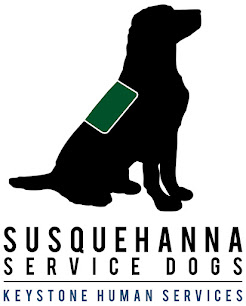Service dogs need to be able to go almost anywhere with
their partner, and that means that the dog needs to be confident about going
into potentially scary situations. (Scary for a dog, that is.) A dog could exhibit fear in a variety of
situations. How do you train a dog to not be afraid?
At Susquehanna Service Dogs, we used to have a saying: “Remember
the back door and keep your dog safe.” This “back door” is your escape route if
your dog is looking or acting fearful.
But what do you do when your dog has bigger fears or they’re
still afraid of the same thing the third time they’ve encountered it?
If your dog sees another dog or a person who looks scary to
them, and starts acting terrified, your best option is to leave and not return.
Why is it a good idea to take the back door and leave in this situation? Every
time your dog experiences extreme worry and starts barking or growling, that
barking and growling is releasing adrenaline, which makes the dog feel better
and rewards the dog each time for this aggressive behavior. Each time the dog
barks or growls with this adrenaline rush reward, the behavior becomes
stronger. This means that it’s harder and maybe even impossible to remove the
aggression with absolute security. By leaving, you prevent your dog from being
rewarded for barking at the scary dog or person. If they’re not rewarded with
that adrenaline rush, it will be easier the next time the dogs sees that scary
dog or person.
Now, sometimes dogs are afraid of objects, like an elevator.
If this is the case, just stop riding elevators for a while, especially if you
have a puppy. It’s possible that the puppy may be going through a fear period
which they will outgrow. Once the puppy has matured a bit, you can try taking
an elevator again. (If you have an SSD dog, make sure you’ve talked to a
trainer about the proper way for service dogs to enter and exit an elevator.)
When you do return to the elevator, make sure you have lots of yummy power
treats with you and only plan on riding the elevator once. Sometimes this will
end the fear and the dog will be recovered. However, be careful not to try different
elevators while your dog is fearful of them. You don’t want to create a
generalized fear of elevators.
When it’s time to introduce a dog to a situation, place,
object, person, or animal that caused the initial fearfulness, try to set it up
in the best possible situation. If your dog is meeting another dog, follow
appropriate dog greeting procedure and make sure that the other dog is sweet,
nice, and never a threat to other dogs. Always start with something easy and
avoid challenging situations.
And remember, if your dog still shows fear, do not press the
point. Take the back door and leave.
What happens if your dog shows fear and worry, and you don’t
have the choice to leave? Just pick the safest option for you and your dog. For
example, if your dog is afraid of the vet’s office, just try to get your dog
inside and use lots of treats. Sometime when you don’t have an appointment, go
back to the vet and just sit in the car and give your dog lots of treats. When your
dog is okay with that, try going inside, give them lots of treats, and leave.
But if you have an appointment, just take the easiest, fastest, and safest way
possible to get your dog inside, so the experience is over as soon as possible.
If you take your dog somewhere and your dog becomes fearful
of a location that that you must go through in order to leave, use the same
method that you would with the vet. Use lots of treats and even lure your dog
with the treats. Get through the fearful location as quickly as possible so you
don’t increase the length of time your dog is anxious. Don’t worry about
clicking. Just give your dog treats. Then the next time you need to go to this
location, make sure you have another plan in place in case your dog still
exhibits fear.
Remember, keep your dog safe and use that back door. When in
doubt, be safe and leave. Don’t practice over and over hoping to acclimate your
dog to the thing they fear. You will most likely just end up making your dog even
more fearful, and that fear will become cemented. Don’t be afraid to ask for
advice and find a new approach. And never net your dog practice aggressive,
fear-based behavior. Every time you let your dog act aggressively, they are
reinforced for the aggression.
There are many other ways to deal with fear. There is
Constructional Aggression Treatment (CAT), Behavior Adjustment Training (BAT),
the “look at that game,” and of course, classical conditioning.
If you have an SSD dog, please call a trainer for advice.






No comments:
Post a Comment